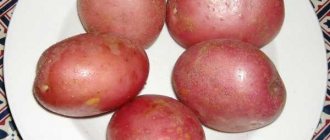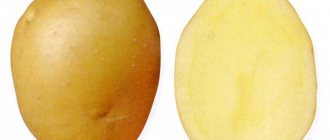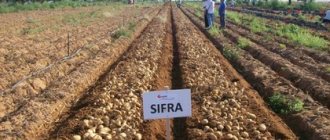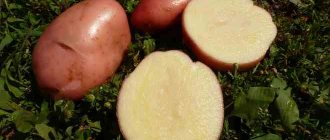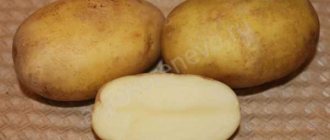History of the variety
The Nevsky potato variety was created at the Research Institute of Agriculture of the North-Western Regions in 1976. It was the result of selection of two other varieties: Candidate and Veselovsky. Nevsky collected the best properties and gained unprecedented popularity on collective farms, and later among private farms. In 1982 it was included in the state register of varieties.
Until now, the Nevsky variety is recognized as the best among those bred in Russia by selective breeding.
Description of the Nevsky potato variety
This variety has a unique ability to survive in different climatic conditions; it easily tolerates rainy periods and high temperatures. Currently, 26% of the areas intended for potatoes in the Russian Federation are given over to the Nevsky variety for sowing, since it is guaranteed to provide the country with a harvest under almost any weather conditions.
Escapes
The height of potato bushes of the Nevsky variety is 50-60 centimeters. The leaves lushly cover the powerful stem. They are wide, oblong, have a bright green color, and the edges of the leaves are wavy.
Flowering is short-lived, the buds are white, have bright orange pistils, and form racemose inflorescences.
Roots
Ripe potatoes are light beige in color, oblong oval in shape with delicate thin smooth skin. The flesh is cream-colored. The eyes are noticeable and pink. The weight of the tubers is 50-130 grams, the starch content is 10-13%.
Main characteristics
In terms of ripening time, it is medium late; from the moment of germination it takes from 70 to 90 days to reach full biological maturity. But the exact timing is determined by the time of planting and the climate of a particular area. Young potatoes are ready to eat at the end of July.
Plants are powerful, erect, slightly spreading. The leaf blades are wide, glossy, light green in color with slight wavy edges. Thanks to this shape of the leaves, the plant survives dry periods more easily and reflects bright UV rays. It blooms profusely, the flowers are large, with a snow-white corolla and a bright yellow center.
On a note!
The flowering period of Nevsky potatoes is short but intense.
The tubers are large, weighing 100-130 grams, regular oval in shape. The eyes on the peel are pinkish, slightly depressed, and small in size. The peel is smooth, thin, beautiful yellowish in color. The flesh is creamy with a pink tint.
The taste of the pulp is excellent, and this is noted by everyone who has tried to grow Nevsky on their plot. In terms of starch content - 10-13%, it is inferior to some varieties, therefore it is usually used for preparing first courses, salads, and frying. For puree, it is recommended to use other varieties, more boiled, with high starch levels.
9-15 aligned tubers are collected from a bush. With proper and proper care, there are few small potatoes on the nest. Average yields are 350-500 centners per hectare (about the same as Sineglazka, Adretta potatoes), but higher than Cornflower, Alvara, Kubanka. The marketability of tubers is high, keeping quality is up to 95%. A special feature of Nevsky is the possibility of rapid germination, so this is taken into account during storage.
Characteristics and features of the variety
The Nevsky potato variety can be described through the following properties:
- ripening time 75-100 days;
- drought-resistant;
- thermophilic;
- not afraid of waterlogged soil;
- good yield;
- shelf life indicator – 95%;
- commercial appearance;
- transportable;
- the taste is highly appreciated by the consumer.
Has good immunity to the following diseases:
- potato cancer;
- scab;
- fusarium;
- verticillium;
- late blight;
- blackleg;
- Alternaria blight.
Potato Nevsky has weak resistance to various types of mosaics, macrosporiosis, and root rot. But the nematode is especially dangerous.
The Colorado potato beetle does not like Nevsky potatoes, and if there are other nightshades on the site or next to it, it will prefer them.
Productivity and taste
One bush of the Nevsky variety produces from 8 to 15 tubers, which means 1.5-2 kg in weight equivalent. From one hectare you can collect from 380 to 500 kilograms of root crops. The most common figure is 450 kilograms. The maximum harvest was 6 centners per hectare.
Most potato lovers highly appreciated the taste characteristics of the Nevsky variety. It is suitable for boiling, baking and frying, as well as for preparing salads and soups. But due to their low starch content, potatoes are not suitable for making mashed potatoes at home or on an industrial scale.
Reviews from gardeners
Nevsky potatoes produce a stable harvest even in unfavorable weather conditions. With good care, the culture reveals its full potential. But we must remember that in order to obtain high yields, it is necessary to observe crop rotation, give the land rest and nutrition.
To increase productivity, farmers feed the crop with potassium sulfate during the flowering period. To do this, dissolve 30 g of the drug in 10 liters of water and water the plantings.
Weeding is carried out as necessary, but at least once a month. To prevent diseases and pests from leading to the death of plants, the plantings are carefully inspected once a week.
“For many years, the variety has remained among our favorites. It does not require complex care or watering, and over time the bushes themselves rid the area of weeds. The yield is stable regardless of weather conditions and on average we remove 10 tubers from a bush. Individual shoots form up to 15 potatoes and small root crops are rare.”
“The taste of potatoes is important to us. Nevsky does not fail in this regard. The most delicious dishes are those that involve frying the product; the crust is thin and golden. A distinctive feature of tubers is their good ability for long-term storage.”
Advantages and disadvantages of the variety
Like any other variety, Nevsky has its strengths and weaknesses. Thanks to breeders, there are much more of the first:
- easily tolerates both drought and high humidity;
- has high immunity to the most common potato diseases;
- tolerates transportation well;
- has a pleasant appearance;
- has excellent taste;
- long shelf life;
- it is difficult to cause mechanical damage to it;
- adapted to the climatic characteristics of different regions.
But Nevsky potatoes also have negative sides:
- unsuitable for making purees;
- nematode worms are dangerous to him;
- Lush tops interfere with weeding.
To simplify the care of potato bushes, you should not plant too close.
Care
Caring for potatoes involves traditional agrotechnical measures:
- Hilling. As soon as the shoots reach a height of 10-15 cm, they are half covered with earth. The next hilling is carried out closer to the flowering period. Simultaneously with hilling, the soil is loosened and weeds are removed. In cool weather, the soil is loosened regularly; in hot weather, it is loosened superficially, breaking up the dry crust of the earth;
- Watering. "Nevsky" requires deep watering every 10 days (during drought - every 5 days). Mulching. To retain moisture in the soil, the beds are covered with straw. In addition, mulching inhibits the rapid growth of weeds;
- Feeding. The variety does not require additional feeding, but the application of mineral fertilizers during the budding period will allow the tubers to gain maximum weight.
Potatoes Tuleevskaya, Rosara, Nevskaya, Mauritius, Red Scarlet:
Features of planting and growing Nevsky potatoes
This variety is unpretentious, but before planting you need to choose a suitable place and time, and also prepare seed material.
Optimal timing and location selection
One of the main characterizing features of the Nevsky potato variety is heat-lovingness. Planting is allowed only when the soil has already warmed up. This condition is especially relevant for regions with frequent spring rains. Neva potatoes are moisture resistant if the soil is already warm. Otherwise it will spoil. When choosing a planting time, you should focus on mid-spring, when there are no night frosts.
There are no special requirements for the soil, but this variety grows best in sandy and loamy soils. It is important that the planting site is unshaded. You cannot plant potatoes in soil where other nightshades, sorghum, and sunflowers previously grew. It is best if last season the following grew in the selected area:
- legumes;
- cabbage;
- beet;
- garlic;
- onion;
- cucumbers;
- oats;
- carrot;
- spices;
- corn.
Preparing the site for planting
In the fall, the earth is dug up, after which mineral fertilizers or cow manure with compost are applied. In the spring, a few days before planting, the soil needs to be rid of weeds, dug up and phosphate fertilizers applied.
Tuber preparation
In the case of Nevsky potatoes, it is very important for the yield to correctly select and prepare the tubers. The selection rules are strict.
Nevsky cannot be cut into pieces or the eyes separated and planted separately. Planting is carried out only with whole sprouted tubers. Scratched tender sprouts will not produce a harvest.
When selecting, you should pay attention to the condition of the potato. The slightest sign of rot or mechanical damage makes the tuber unusable. Their weight should not exceed 80 grams and be less than 60 grams.
Before germination, root crops must be treated with a solution of potassium permanganate for disinfection. The tubers should either be washed or kept in it for 3-4 minutes.
Then they are laid out in one layer in a warm, dry room for 2-3 weeks. Planting is carried out when the sprouts are just emerging, and they are still difficult to damage. Their height should not exceed 3 centimeters.
If the potatoes have already sprouted and the weather is still cold, then place the planting material in a cool place. This will stop growth and harden the tubers.
Planting in the ground, planting pattern and depth
Planting is carried out in heated soil. If bad weather continues in May, it is better to plant potatoes earlier, otherwise they will not ripen until autumn.
The planting depth is 20 centimeters. The distance between the holes must be at least 50 centimeters; sometimes 30 centimeters are allowed. There is more than half a meter between the rows.
Sprouted tubers are placed and buried in the ground very carefully to avoid possible damage. After this, if there is dry soil, the first watering is carried out.
Fertilizer application
Potatoes of the Nevsky variety are fertilized once during planting. In the future, the plant does not need it. Before placing the seed material, fertilizer is poured onto the bottom of the dug hole. It can be:
- cow dung;
- wood ash;
- eggshell;
- bird droppings.
If the soil is noticeably depleted, then fertilizing during potato growth is allowed:
- After the first stems appear, pour urea solution under the root (half a liter per bush).
- Before flowering - a solution of wood ash and superphosphate in a ratio of 10:1.
- During flowering - a weak solution of superphosphate.
Care
In the absence of rain, watering the Nevsky variety is carried out 2-3 times a week. To ensure a drip effect, it is better to use a spray bottle. It is necessary to water in the morning or evening, when there is no direct sunlight.
The first shoots will appear 15-20 days after planting. Before this, you already need to carry out weeding and loosening the soil. During potato growth, these procedures are repeated at least 4 times.
When the sprouts reach a height of 15 centimeters, the first hilling is carried out. You should carefully rake the soil so that it does not get on the leaves or in the axils. The potatoes are earthed for the second time when the sprouts reach 30 centimeters. The procedure is performed in cloudy weather on moist soil.
Landing rules
The agricultural technology of the Nevsky variety is very simple. In the southern regions, the hybrid is planted at the end of April, in more northern latitudes - at the beginning and middle of May, when the threat of spring frosts has passed. Planting material is pre-germinated and processed.
To do this, potatoes are sorted, affected specimens are discarded, calibrated and left in direct sunlight in a warm room with a temperature of at least +15 °C.
Before planting, root crops are treated with growth stimulants (Poteitin) and a solution of potassium permanganate, which ensures disinfection of the planting material.
This hybrid feels great on any soil, but shows the most intensive growth on sandy loam and loam. You shouldn’t plant it in lowlands either. Groundwater should not come closer to the surface than 1-1.2 m. The variety is classified as a heat-loving species, so the area should be well lit.
Nevsky potatoes are planted in rows, at a distance of 40-50 cm from each other. Tubers are placed in a hole 18-20 cm deep, so that their sprouts “look” upward. In case of poor soil, it is additionally fertilized with wood ash or bone meal, which is placed directly into the planting hole.
Protection from diseases and pests
Potatoes of the Nevsky variety are resistant to most diseases, but nematodes pose a particular risk. To avoid infection with nematode worms, you must:
- loosen and cultivate the soil;
- carry out careful selection of seed material;
- adhere to crop rotation;
- If infected bushes are found, immediately remove and burn them, and treat the rest with Phosfamide.
To prevent potatoes from getting late blight, you need to adhere to the conditions for caring for the vegetable and spray the bushes twice a month with a solution of copper sulfate.
To protect against mice and insect pests, holes are dug in the area, poison and ultrasonic repellers are laid out.
The Colorado potato beetle is removed by hand. Insecticide preparations are used as poison: Iskra, Regent, Antizhuk, Prestige, Corado, Konfidor, Aktara.
You need to get rid of the mole cricket in advance. In the spring, a manure heap is placed in the area chosen for potatoes; the insect will lay its larvae in it. Shortly before planting the potatoes, the pile is burned. During spring digging, you can add large egg shells to the soil - the insect will get hurt and leave the area. To combat mole crickets, Medvetox and Bazudin are used. The latter is also effective against wireworms, a worm that damages tubers.
Harvest and storage
Young potatoes of the Nevsky variety are harvested in mid-July. The root crop is carefully removed by hand so as not to damage the entire root system. Full ripening occurs at the end of summer. You need to dig up the potatoes before the first cold weather. It is better to clean in dry weather. It is important to ensure that the shovel enters no closer than 20 centimeters from the bush.
After removing from the ground, place the potatoes in a ventilated area to dry. When it dries, the fruits are cleaned of dirt, damaged tubers are selected, and the rest are put into bags/boxes and sent to the cellar. These potatoes are best stored at a temperature of +8 degrees Celsius.
Not every vegetable grows equally stably in both dry and rainy climates. This tolerance to climatic extremes makes the Nevsky variety universal for many public and private farms. It is valued for its unpretentiousness, long shelf life, high immunity and excellent taste.
0
0
Copy link
